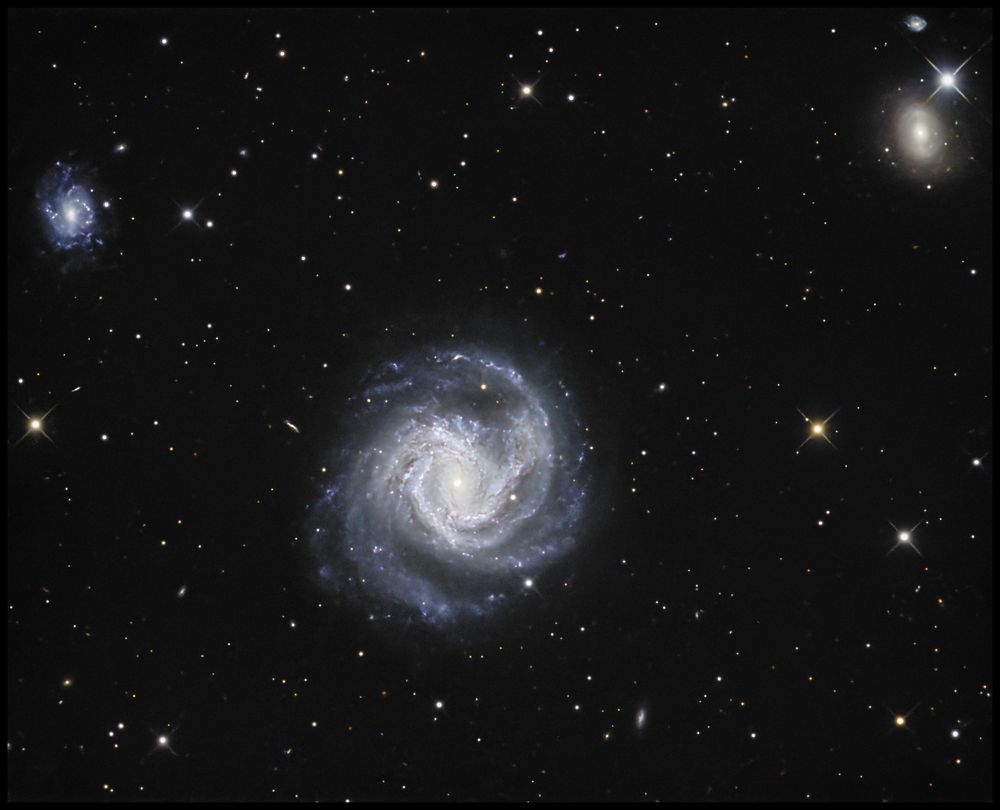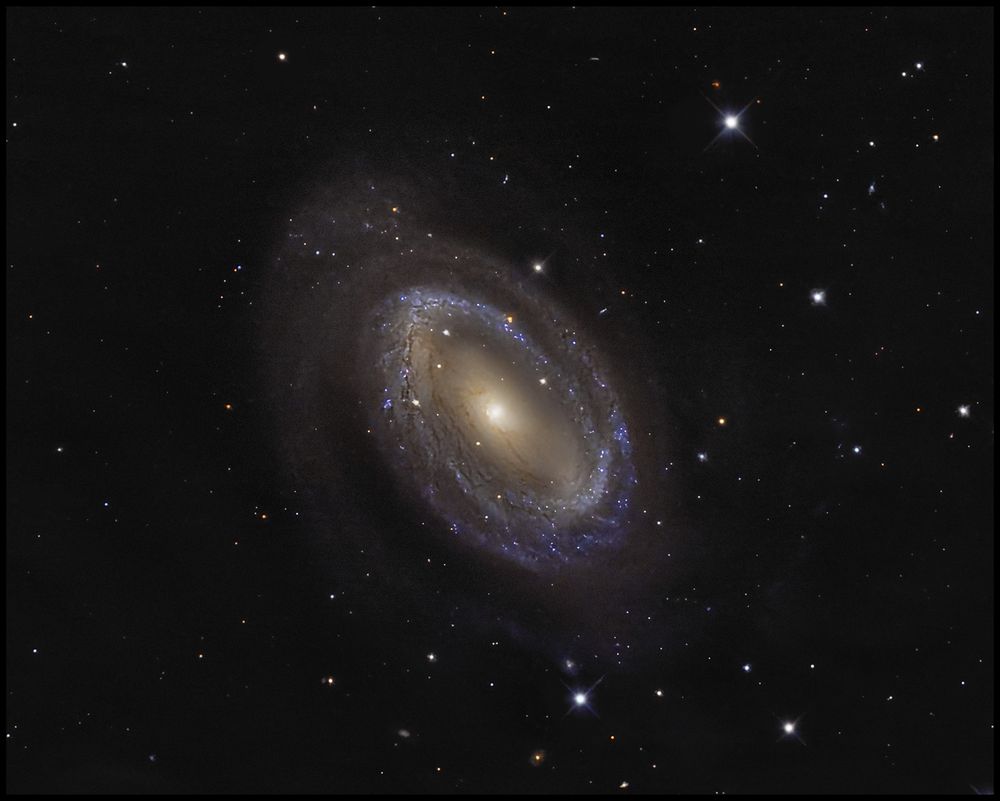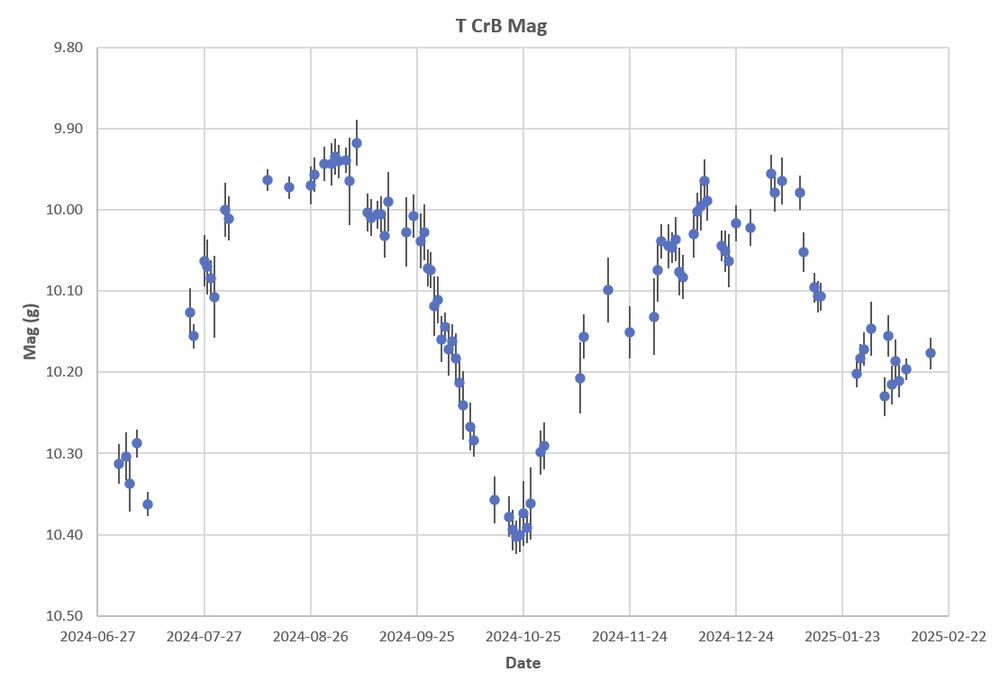Chris Peterson
@cloudbait.bsky.social
Physicist, astronomer, astroimager, nature photographer, advocate for progressive change.
https://cloudbait.com
https://cloudbait.com
Two beautiful comets in our sky right now, C/2025 A6 (Lemmon) with its solar wind buffeted ion tail, and C/2025 R2 (Swan), currently showing a faint dust tail. Both are still getting brighter and can be easily seen in binoculars. #cloudbait #astronomy #astrophotography #comets


October 15, 2025 at 3:37 PM
Two beautiful comets in our sky right now, C/2025 A6 (Lemmon) with its solar wind buffeted ion tail, and C/2025 R2 (Swan), currently showing a faint dust tail. Both are still getting brighter and can be easily seen in binoculars. #cloudbait #astronomy #astrophotography #comets
C/2025 N1, the comet born around another star, now zooming through our solar system, far too fast to be captured by the Sun. This is its motion over about 2.5 hours on 26 July. Only the third interstellar object ever detected. #astronomy #astrophotography #cloudbait
July 26, 2025 at 7:58 PM
C/2025 N1, the comet born around another star, now zooming through our solar system, far too fast to be captured by the Sun. This is its motion over about 2.5 hours on 26 July. Only the third interstellar object ever detected. #astronomy #astrophotography #cloudbait
A supernova in NGC 7331 was discovered on 14 July. It's very near the galaxy core, about magnitude 17. Captured here with 80 min each RGB, animated against the same target imaged in 2022. #astronomy #astrophotography #cloudbait
July 21, 2025 at 5:42 PM
A supernova in NGC 7331 was discovered on 14 July. It's very near the galaxy core, about magnitude 17. Captured here with 80 min each RGB, animated against the same target imaged in 2022. #astronomy #astrophotography #cloudbait
Sharpless 101, the Tulip Nebula in Cygnus. Captured here in the Hubble palette, red is sulfur, green is hydrogen, blue is oxygen. Only an hour each of SHO data. #astronomy #astrophotography #cloudbait

June 24, 2025 at 8:52 PM
Sharpless 101, the Tulip Nebula in Cygnus. Captured here in the Hubble palette, red is sulfur, green is hydrogen, blue is oxygen. Only an hour each of SHO data. #astronomy #astrophotography #cloudbait
The eastern part of Barnard 150, also known as the Seahorse Nebula (this would be the head). This dark nebula consists of thick dust, inside of which new stars are forming. 6 hours each RGB (getting hard this time of year, with so few hours of dark). #astronomy #astrophotography #cloudbait

June 21, 2025 at 4:24 PM
The eastern part of Barnard 150, also known as the Seahorse Nebula (this would be the head). This dark nebula consists of thick dust, inside of which new stars are forming. 6 hours each RGB (getting hard this time of year, with so few hours of dark). #astronomy #astrophotography #cloudbait
M13, the biggest and best globular cluster in the northern skies. Maybe as many as a half million stars! 90 minutes each RGB. #astronomy #astrophotography #cloudbait

June 3, 2025 at 4:30 PM
M13, the biggest and best globular cluster in the northern skies. Maybe as many as a half million stars! 90 minutes each RGB. #astronomy #astrophotography #cloudbait
NGC 4038/4039, the Antennae galaxies. Tricky for me because it's very low in the southern sky, and both the top of my observatory wall and some tree branches interfere. That's what created those odd JWST-like diffraction spikes. 40 min each RGB, 60 min lum. #astronomy #astrophotography #cloudbait

May 24, 2025 at 7:50 PM
NGC 4038/4039, the Antennae galaxies. Tricky for me because it's very low in the southern sky, and both the top of my observatory wall and some tree branches interfere. That's what created those odd JWST-like diffraction spikes. 40 min each RGB, 60 min lum. #astronomy #astrophotography #cloudbait
M101, the Pinwheel Galaxy in Ursa Major. Too big for my camera FOV, so shot as a 2x2 panel mosaic. Each panel: 60 min lum, 40 min H-alpha, 20 min each RGB. Imaged over the last two nights. #astronomy #astrophotography #cloudbait

May 22, 2025 at 4:32 AM
M101, the Pinwheel Galaxy in Ursa Major. Too big for my camera FOV, so shot as a 2x2 panel mosaic. Each panel: 60 min lum, 40 min H-alpha, 20 min each RGB. Imaged over the last two nights. #astronomy #astrophotography #cloudbait
M61, a barred spiral in Virgo. Framed here to capture NGC4301 (upper left) and NGC4292 (upper right). 100 minutes each RGB. A few other galaxies scattered around the image, as well. #astronomy #astrophotography

May 4, 2025 at 5:48 PM
M61, a barred spiral in Virgo. Framed here to capture NGC4301 (upper left) and NGC4292 (upper right). 100 minutes each RGB. A few other galaxies scattered around the image, as well. #astronomy #astrophotography
Messier 94, aka the Croc's Eye Galaxy. It displays an interesting ring of intense star formation near its center. 6 hours L, 45 min each RGB. #astronomy #astrophotography

April 20, 2025 at 5:47 PM
Messier 94, aka the Croc's Eye Galaxy. It displays an interesting ring of intense star formation near its center. 6 hours L, 45 min each RGB. #astronomy #astrophotography
NGC 2024, the Flame Nebula. A rich star forming region full of glowing hydrogen and sculpted dust lanes. The blue glow at the lower right is scattered light from Alnitak, one of Orion's belt stars. 40 min each RGB. #astronomy #astrophotography

April 13, 2025 at 3:51 PM
NGC 2024, the Flame Nebula. A rich star forming region full of glowing hydrogen and sculpted dust lanes. The blue glow at the lower right is scattered light from Alnitak, one of Orion's belt stars. 40 min each RGB. #astronomy #astrophotography
NGC 4676, The Mice. One of the coolest interacting galaxy pairs out there. 6 hours lum, 1 hour each RGB. #astronomy #astrophotography

April 11, 2025 at 6:02 PM
NGC 4676, The Mice. One of the coolest interacting galaxy pairs out there. 6 hours lum, 1 hour each RGB. #astronomy #astrophotography
Rosette Nebula, central region in H-alpha. This is a four-panel mosaic made under excellent seeing conditions, an hour of exposure for each quadrant. #astronomy #astrophotography

April 3, 2025 at 9:27 PM
Rosette Nebula, central region in H-alpha. This is a four-panel mosaic made under excellent seeing conditions, an hour of exposure for each quadrant. #astronomy #astrophotography
Well, a bit of snow last night, so the observatory was closed. For compensation, a beautiful sunrise this morning, coming up from behind Pikes Peak. Springtime in the Rockies. #photography

March 31, 2025 at 1:57 AM
Well, a bit of snow last night, so the observatory was closed. For compensation, a beautiful sunrise this morning, coming up from behind Pikes Peak. Springtime in the Rockies. #photography
NGC 281, the Pacman Nebula. Just the central part, so the "Pacman" isn't apparent. Recently reprocessed Hubble palette image from data collected in 2023. 3 hours each [S II], H-alpha, [O III]. #astronomy #astrophotography

March 29, 2025 at 4:56 PM
NGC 281, the Pacman Nebula. Just the central part, so the "Pacman" isn't apparent. Recently reprocessed Hubble palette image from data collected in 2023. 3 hours each [S II], H-alpha, [O III]. #astronomy #astrophotography
NGC 4725, a one-armed barred spiral galaxy in Coma Berenices. About 3 hours luminance and 40 minutes each RGB. #astronomy #astrophotography

March 24, 2025 at 9:56 PM
NGC 4725, a one-armed barred spiral galaxy in Coma Berenices. About 3 hours luminance and 40 minutes each RGB. #astronomy #astrophotography
NGC 5218 and NGC 5216, together cataloged as Arp 104 or Keenan's system (in Ursa Major). A spiral and an elliptical bridged by some kind of tidal tail. Usually these sorts of tails are faint, but this entire system is bright, recorded here with only two hours each RGB. #astronomy #astrophotography

March 23, 2025 at 4:31 PM
NGC 5218 and NGC 5216, together cataloged as Arp 104 or Keenan's system (in Ursa Major). A spiral and an elliptical bridged by some kind of tidal tail. Usually these sorts of tails are faint, but this entire system is bright, recorded here with only two hours each RGB. #astronomy #astrophotography
Messier 82, the Cigar Galaxy. A nearly edge-on, distorted starburst galaxy that is ejecting large amounts of hydrogen from its center, driven by frequent supernovas. 4h H-alpha, 2.5h lum, 5h each RGB, collected in 5 sessions over the last 5 years. #astronomy #astrophotography

March 15, 2025 at 12:12 AM
Messier 82, the Cigar Galaxy. A nearly edge-on, distorted starburst galaxy that is ejecting large amounts of hydrogen from its center, driven by frequent supernovas. 4h H-alpha, 2.5h lum, 5h each RGB, collected in 5 sessions over the last 5 years. #astronomy #astrophotography
NGC 2359, Thor's Helmet, emission nebula in Canis Major. 30 min each RGB + 1 hour [O III]. #astronomy #astrophotography

February 28, 2025 at 3:17 PM
NGC 2359, Thor's Helmet, emission nebula in Canis Major. 30 min each RGB + 1 hour [O III]. #astronomy #astrophotography
Leo Triplet... all the parts, separate sessions; too big for my FOV. NGC 3628, 160 min each RGB. M 66, 44 min each RGB. M 65, 3 hours each RGB. Relative sizes and orientations are accurate (all are north up), but spacing between them isn't. #astronomy #astrophotography

February 26, 2025 at 12:26 AM
Leo Triplet... all the parts, separate sessions; too big for my FOV. NGC 3628, 160 min each RGB. M 66, 44 min each RGB. M 65, 3 hours each RGB. Relative sizes and orientations are accurate (all are north up), but spacing between them isn't. #astronomy #astrophotography
M 42, the Orion Nebula. For such a bright object it's one of the toughest to image and process because of the huge dynamic range. This is a 2x2 mosaic of images, only 15 minutes each RGB per quadrant (3 hours total exposure time), utilizing HDR processing. #astronomy #astrophotography

February 22, 2025 at 9:58 PM
M 42, the Orion Nebula. For such a bright object it's one of the toughest to image and process because of the huge dynamic range. This is a 2x2 mosaic of images, only 15 minutes each RGB per quadrant (3 hours total exposure time), utilizing HDR processing. #astronomy #astrophotography
M1, the Crab Nebula, over 22 years. First image from 2002 (with an SCT, so no diffraction spikes), second from 2024 (RC showing diffraction). And a high proper motion star in the upper right (TYC 1309-1640-1). Pretty obvious expansion. #astronomy #astrophotography
February 21, 2025 at 12:39 AM
M1, the Crab Nebula, over 22 years. First image from 2002 (with an SCT, so no diffraction spikes), second from 2024 (RC showing diffraction). And a high proper motion star in the upper right (TYC 1309-1640-1). Pretty obvious expansion. #astronomy #astrophotography
M 81, Bode's Galaxy in Ursa Major. I combined data from last February with a new run last night to get this. 3 hours each RGB. #astronomy #astrophotography

February 19, 2025 at 5:49 PM
M 81, Bode's Galaxy in Ursa Major. I combined data from last February with a new run last night to get this. 3 hours each RGB. #astronomy #astrophotography
Started my observing campaign of recurrent nova T Coronae Borealis (T CrB) last July, collecting on most clear nights (lots of those in the Colorado high country). Still waiting for the outburst, but I've now recorded over 228 days, which is one full variability cycle.
#Astronomy #TCrB
#Astronomy #TCrB

February 19, 2025 at 12:48 AM
Started my observing campaign of recurrent nova T Coronae Borealis (T CrB) last July, collecting on most clear nights (lots of those in the Colorado high country). Still waiting for the outburst, but I've now recorded over 228 days, which is one full variability cycle.
#Astronomy #TCrB
#Astronomy #TCrB
NGC 6951, a pretty barred spiral in Cepheus. While it is around 75 million light years away, the faint dust around it is much closer, above the galactic plane and illuminated by the integrated light of the Milky Way. 2 hours each RGB + 8 hours luminance. #astronomy #astrophotography

February 18, 2025 at 2:18 PM
NGC 6951, a pretty barred spiral in Cepheus. While it is around 75 million light years away, the faint dust around it is much closer, above the galactic plane and illuminated by the integrated light of the Milky Way. 2 hours each RGB + 8 hours luminance. #astronomy #astrophotography

